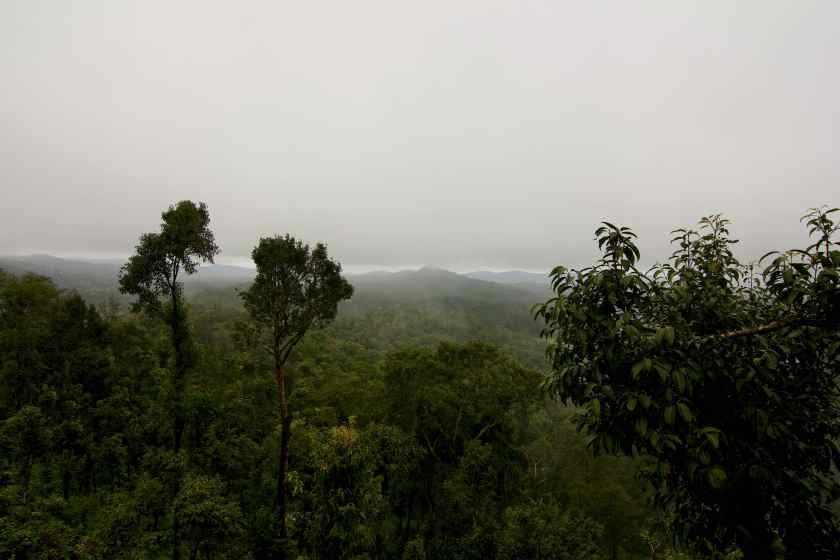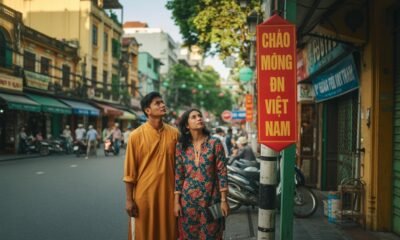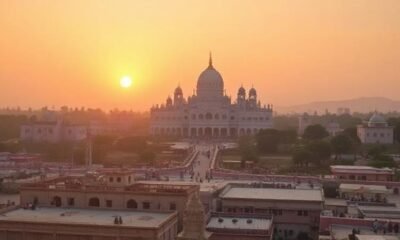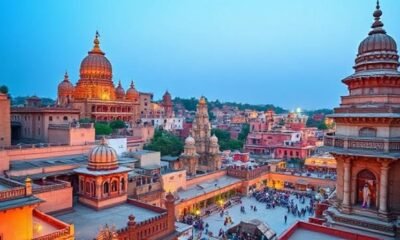Travel Guides & Articles
Coorg, Varkala, Kodaikanal, Yelagiri, Wayanad: Now Discover India’s Most Tranquil Getaways This Monsoon

Sunday, August 3, 2025
For anyone ready to hit pause, breathe deep, and let the rain wash away the noise, Southern India has a whole roster of crowd-free monsoon havens. The air is green, the hills are cloud-kissed, and the quiet is the loudest invitation to slow down. Whether you drift toward shaded hill towns, windswept cliff-top vistas, or the heart of candle-lit rainforests, each stop is a quiet nudge back to yourself.
Heritage homestays, bamboo-framed eco-lodges, and beachfront palm huts are waiting. Here are five quiet corners you can slip into this season to feel the skies soften and the batteries refill.
1. Blyton Bungalow by Beforest, Coorg, Karnataka
Tucked inside Karnataka’s Western Ghats, Coorg is a long-time favorite for anyone chasing a hush. Mornings roll in cloaked in mist, rows of coffee trees stretch in slow some distance, and large bungalows sit still atop hills. Blyton Bungalow, a rubber- and coffee-plantation home run by Beforest, sits right in a coffee circle, the green hills rolling away in waves. Perfect for a solo stop, the bungalow hushes all signals, letting you wander the estate paths, watch the rain drum, or drift into a good book with the scent of wet earth drifting past.
2. The Sanctum Spring Beach Resort, Varkala, Kerala
Clinging to the North Cliff, The Sanctum Spring Beach Resort feels like a well-kept secret in Varkala, Kerala. Unlike the busier coast, this place is cool and easy on the senses. Soft-cream lodges sprinkle the cliff, where lilting Ayurvedic therapies, quiet yoga sessions, and the occasional fairy-light glow of a café weave relaxed days. The horizon spills right under your feet, the private snug beaches wait for bare feet, and the little crowd is the crowd you want: people here for the sun and stillness, not for shows.
When the monsoon whispers, the cliff rain adds gentle percussion to yoga mats and chill hammocks. Whether you’re a solo soul, a quiet couple, or a family wanting to softly rewind, this stretch of Kerala invites you to stay, slowness in every wave and leaf.
3. The Tamara Kodai, Kodaikanal, Tamil Nadu
Kodaikanal’s hills always offer relief from summer heat, but in the monsoon they bring a special, quiet beauty. Soft mist hugs each relief and glade, and the air fills with the scent of damp pine and childhood dreams. The Tamara Kodai rises at the edge of the lake and the inn, a lovingly restored 1840s chapel, combines the still grace of heritage with every comfort the modern traveler might wish.
The gentle rain beats a soothing rhythm on the slate roofs, and from the cottage verandas guests can watch clouds slide in silver and white. Strolling the lake’s edge, hiking misty paths, or curling in the hush of a soft lamp-lit room, time can almost be felt slowing down. Each experience, whether simple or grand, is colored by the special hush of monsoon Kodaikanal and by the unshakeable charm of the hills.
4. Zeenath Taj Gardens, Yelagiri, Tamil Nadu
Yelagiri doesn’t chase popularity, and that is why it still feels like a secret the hills are guarding. At Zeenath Taj Gardens, a white-walled guesthouse in the gentle colonial style, gardens thrum with the laughter of crickets and the scent of fresh jasmine and the valley below unfolds like a country quilt. Families and solo souls find the hush they came for, and there are no screens to break it.
Mornings begin with clouds softening the view, and afternoons with the slow invitation of the swimming pool. Here, a walk might mean a stone path through roses, or a seat beneath a listening tree with a book borrowed from the shelf in the hall. The balance between stillness and gentle comfort makes every moment feel like a small, quiet celebration.
With its clean, mountain air, gentle slopes, and chill vibe, Yelagiri is the kind of place that makes the rainy season feel like a warm hug. Longer-than-usual walks, a pile of novels, or just staring at greens and blues everything here feels effortless and free.
5. Wayanad Wild by CGH Earth, Wayanad, Kerala
Wayanad is Kerala’s quiet jewel, a place where the monsoon feels like magic. Rolling mists, cardamom valleys, and quiet lakes pull you into a world where trees whisper and water reflects clouds. Wayanad Wild by CGH Earth is a low-impact hideaway set deep in the forest, and when you step inside, the outside world feels like a dream. Start your day with the call of a hornbill, follow shaded paths that wind in and out of fog, and let the wild earth wrap around you.
Pouring rain makes Wayanad even more alive. Wait until the downpour starts, and the hills paint themselves a richer green. Breezes feel cooler, and every droplet sounds like music falling on leaves. You feel your stress drain away, leaving a calm that stretches deep. It’s the kind of place that calls out to hikers, bird-watchers, and anyone looking to feel their feet on living ground again.
Embrace the Monsoon in Southern India
When the southwest monsoon sweeps across Southern India, the region blooms in every shade of green. Perfect for revitalizing a tired spirit, the misty hills of Coorg, the quiet sands of Varkala, and the mountain-draped charm of Kodaikanal invite you to slow down and breathe. Coorg’s coffee estates wrap you in cool, fragrant air; Varkala’s cliffs rise above tranquil seas, offering the soft rhythm of waves, and Kodaikanal, draped in lavender clouds, grants you cozy corners with steaming cups of cardamom tea.
At every stop, you choose how to unwind. Curling beside a crackling fire in a hillside estate, meditating on a tranquil beach after a rain, or wandering through bamboo-fringed trails, you slip into the gentle heartbeat of the region. This monsoon, trade your busy routine for the peace Southern India serves like cool rain on sun-baked soil.
Travel Guides & Articles
‘India’s Marriot is Taj’, Royal Orchid’s forte is India ethos

The company currently operates 7,167 keys across 118 hotels with another 2,500-plus rooms under development, and plans to add about 230 hotels over the next five years, taking the portfolio to 22,000 keys by FY30.
Baljee is clear about how he wants the group to be perceived. “We won’t be India’s Marriott. India’s Marriott is Taj,” he told Mint. “We’re building a distinctly Indian portfolio, with Indian roots and values, present wherever the Indian travels, at home and across the diaspora.”
For him, signing new assets is the easy part. Royal Orchid has “about 60-odd” in the bag and expects to add around 40 properties over the next 12 months, but executing them with the right brand fit and return on capital is what will matter.
At the premium end sits ICONIQA, an upscale lifestyle brand launched in Mumbai, which will be capped at eight hotels by 2030, given the design and investment intensity. Crestoria, a leisure-focused offering, will debut in the hills outside Dehradun shortly and could grow to 25 properties over the next five years.
The mid-market will continue to be led by Regenta and Regenta Place, while the biggest thrust will come from Regenta Z, a tech-first economy franchise that aims to ‘brandify’ India’s unorganised neighbourhood hotels with standardised rooms, hygiene systems and digital rails. “Every neighbourhood in India has a hotel. The dream is to bring them into the fold,” Baljee said. Flexi-lease structures typically involve ₹5-10 crore per asset, but are booked as advance rent recoverable from owners, helping the group scale without straining its balance sheet.
Financial discipline meets growth ambition
Royal Orchid ended FY25 with nearly 10% growth in consolidated income, up to ₹343.18 crore from ₹312.70 crore the year before, while earnings before interest, taxes, depreciation, and amortization (EBITDA) rose modestly to ₹96.8 crore. Net profit eased to ₹47.5 crore as against ₹50.8 crore a year earlier, though return on capital employed improved to 17.3%.
In Q1 of FY26, the company posted a 28% jump in profit after tax to ₹11.2 crore, with consolidated income at ₹82.8 crore, up 6.6% year-on-year. Free cash flow of about ₹55 crore is expected this year, with 40% earmarked for growth and another 40% for internal improvements and brownfield expansions.
Baljee insists that Royal Orchid’s growth filters are straightforward: brands must mean something to guests, execution must be meticulous from design to service, and every project must deliver high returns on capital. “If all three are met, we’ll do the hotel,” he said. Domestic demand is at the core of the plan. “India has 100 million people travelling. International inflow is a bonus,” he added.
The average room rates, he believes, will keep climbing steadily as higher-quality supply enters and independents come under brands. “Record highs will keep getting reset, subject to the world not falling apart.”
GST, infrastructure and the road ahead
While upbeat on growth, Baljee cautioned that tax policy could alter economics in unexpected ways. The reduction of the goods and services tax rate from 12% to 5% for hotels in the lower tier, he said, looks positive at the first glance but carries a hidden sting: the inability to claim input credit on supplies and lease rentals. “It increases operating costs, especially in the mid- and lower-mid market, and may get passed on to customers,” he said.
The company’s network spans 80 cities, but the ambition is to be in all 560 district headquarters and then deepen presence in mature markets. Baljee sees opportunity in both metros and micro-locations: from Amritsar in Punjab, where Royal Orchid already has five hotels and is planning more, to Gujarat’s Kevadia, home to the Statue of Unity, where new demand nodes are emerging.
The company is also betting on India’s growing events economy, from Coldplay weekends to G20-style summits, but Baljee stressed that scalability depends on public transport and venue infrastructure. Around the Mumbai-Ahmedabad bullet train corridor, Royal Orchid is developing a large hotel in Surat to capture the expected surge in demand.
Risks remain familiar: an economic downturn could stall momentum, and execution lapses are a constant challenge in an asset-light model reliant on developers. But Baljee is bullish. “We’ve invested heavily in the team and systems to align on a long-term vision, not just quarterly optics,” he said.
Travel Guides & Articles
India’s first Vande Bharat Sleeper Express to link Delhi to this city: Check dates and more details

Unlike the existing Vande Bharat Express trains, which are mainly chair-car services suited for day travel, this new model has been designed specifically for overnight trips. With a maximum speed of 180 km/h, the train is expected to halve journey times on long-distance services. For instance, the Rajdhani Express currently takes close to 23 hours to cover the same route.
The Vande Bharat Sleeper has been manufactured using advanced Integral Coach Factory (ICF) technology by Bharat Earth Movers Limited (BEML). It is equipped with a host of modern features including CCTV cameras for enhanced security, LED screens for information and entertainment, automatic doors with sensors for safe boarding, modern fire safety systems and on-board announcement facilities. The interiors have been designed with an aircraft-style finish, giving passengers a premium travel experience.
Also read | Nanded-Mumbai Vande Bharat Express: Fare, timings, route and stations
The train is expected to leave Patna at 8 pm and reach Delhi by 7.30 am the next day, enabling overnight travel and saving time for passengers. The return journey from Delhi will follow a similar overnight schedule. Fares are projected to be 10–15% higher than the Rajdhani Express, but officials suggest that the shorter journey time and upgraded amenities more than justify the difference in cost of the tickets. Compared to flights, the Vande Bharat Sleeper Express offers a pocket-friendly alternative while maintaining high comfort levels.
The Vande Bharat Express, first launched in 2019, has become a flagship service of the Indian Railways. Currently operating on seven routes across the country, these semi-high-speed trains have received strong passenger demand thanks to their speed, safety and comfort. With the introduction of the sleeper version, the government aims to expand the reach of the service, particularly for long-distance routes where overnight travel is common. More sleeper variants and upgraded versions are already in the pipeline, signalling a major transformation in train travel across India.
The Delhi–Patna route is among the busiest in the country, especially during festive seasons when millions of people travel between the capital and Bihar. The Vande Bharat Sleeper Express is expected to ease congestion, provide passengers with a faster travel option, and boost connectivity for both Bihar and Uttar Pradesh. Officials believe this will support regional development by improving business travel and tourism links between north India and the capital.
Also read | Vande Bharat Ticket Booking: Now you can reserve your seat even 15 minutes before departure
(Edited by : Jerome Anthony)
Travel Guides & Articles
Australia Marketplace India 2025 Captures India’s Growing Travel Potential

Tourism Australia hosted its 19th edition of Australia Marketplace India (AMI) at Fairmont Jaipur from August 3 to 6, 2025. This flagship trade engagement platform continues to strengthen Australia’s presence in one of its fastest-growing source markets. With record participation from eight Australian states and strong buyer interest from over 100 leading Indian travel operators, the platform reinforces Australia’s long-term commitment to the Indian market and its confidence in sustained double-digit growth.
Tourism Australia is witnessing strong momentum from India, as it firmly establishes itself as Australia’s fifth-largest market. Arrivals reached 453,000 in the year ending May 2025, a 10 per cent increase, while spending rose 14 per cent to AUD 2.7 billion. Tourism Australia’s leadership, Jennifer Doig, Regional General Manager for South and Southeast Asia, Nishant Kashikar, Country Manager – India and Gulf, Tourism Australia, and Jane Phillips, General Manager Distribution, Development and Partnerships, outlined the organisation’s strategic priorities and vision for the year ahead, reaffirming India’s critical role in Australia’s inbound tourism narrative.
Trade at its Best
With India emerging as a high-potential source of quality outbound travellers, AMI 2025 witnessed strong engagement from the Indian travel trade and record Australian representation across accommodation, tours, attractions, experiences, and state and regional tourism organisations, including several first-time participants.
The buzzing marketplace floor set the tone for purposeful business, where knowledge exchange and relationship-building unfolded in a seamless, well-timed format. The resplendent host hotel, with its discreet luxury, elevated the experience, balancing serious trade discussions with moments of relaxed networking over delightful culinary presentations. Evenings brought a lighter touch as clever icebreakers gave way to Bollywood-inspired camaraderie, as participants rehearsed and performed blockbuster dance numbers with interesting props and flawless thumkas. The following night saw delegates donning elegant Indian formal wear, cementing the bonds formed on the trade floor in the warmth of celebration.
Stronger Ties, Stronger Numbers
Adding to this momentum, Jennifer highlighted the collaborative spirit that AMI fosters. She shared, “Australia Marketplace India is a significant programme on the Tourism Australia calendar because it brings together the very best travel agents from across India and allows our Australian tourism stakeholders to showcase all the latest products and experiences for the Indian traveller. We are working closely with the stakeholders to ensure they truly understand the Indian market.”
Reflecting on India’s tourism growth to Australia, Nishant described it as a ‘positive upward trajectory,’ highlighting four key trends. He said, “We continue to be the fastest-growing inbound market for tourism in Australia, from being the seventh-largest market pre-COVID, to the fifth-largest and also one of the most promising markets for the future. The second highlight is that arrivals crossed the 450,000 milestone, a 10 per cent increase compared to the previous year. Thirdly, Indians are not just travelling, they are also spending more on Australian holidays. Spends by Indian tourists went up by almost 14 per cent to reach $2.7 billion, with a per capita holiday spend of over 7,000 Australian dollars. Indian travellers are also staying longer, and cumulative nights reached almost 29 million, a 21 per cent increase over the previous year, reflecting travel beyond the main cities into new states and regions across Australia. Lastly, the presence of all eight state and territory tourism organisations from Australia for the first time at AMI clearly shows the potential they see in India and their intent to capitalise on it.”
On her first visit to India, Jane shared her excitement about attending this power-packed edition in Jaipur. She noted, “It is clear that India is absolutely on the rise. Last year, we released a paper called The Future of Distribution on our Tourism Australia website, highlighting key trends. We are here to share better insights with the Indian trade, and the enthusiasm for selling Australia is fantastic.”
Catalysts of Growth
Visas are often the make-or-break factor, and Australia has cracked the code in making them effortless. There are no interviews, biometrics, personal visits, long queues, and everything is fully digitised. Applications can be submitted 24/7, and eligible travellers can receive up to a three-year multiple-entry visa for leisure or a five-year multiple-entry visa for MICE. Delivered in close collaboration with Australia’s Department of Home Affairs, this seamless system is reshaping access to the country.
Aviation remains key to growth, with 25 per cent of traffic on direct flights and 75 per cent via one-stop carriers like Singapore Airlines, Malaysia Airlines, Thai Airways, Cathay Pacific, and AirAsia. Capacity has risen with new direct services from Qantas and Air India, underscoring aviation’s strategic role in future success.
Seasonality is a key growth driver, with Indian travel to Australia peaking in May during summer holidays and again in December, aligning with Australia’s holiday season and major sporting events. Additionally, the growing Indian diaspora in Australia, now approaching one million, along with over 100,000 Indian students, reinforces the strong people-to-people links between the two countries.
Strategy at Play
This momentum has been sustained by targeted media outreach, impactful storytelling, and PR initiatives tailored to attract high-yield travellers. Nishant highlighted the success of its recent celebrity-led campaign, which achieved a cumulative reach of 70 million on social media and an earned media value of AUD 120 million as one of its most impactful promotions to date. Translating awareness into conversions, the organisation worked closely with land and airline partners to design practical campaigns, expand regional packages, and drive measurable results.
Tourism Australia’s Aussie Specialist Program continues to deliver strong results, with 3,200 trained specialists across India clocking a 90 per cent increase. The Aussie Specialist team delivered over 3,600 trainings in the past year, up 27 per cent, helping agents build confidence in selling Australia. The programme spans metros and Tier 2 cities and operates both in-person and online, ensuring a broad reach. Jane highlighted, “The Aussie Specialist Program lets agents across India learn online at their own pace. At AMI 2025, 90 per cent of participating agents were Aussie Specialists, with feedback confirming strong confidence in selling the destination.” Trade engagement continues to grow, exemplified by a record 45 Indian agencies attending the Australian Tourism Exchange in Brisbane last year. Tourism Australia also supports the Indian travel trade through key global events such as the Australian Tourism Exchange and G’day Australia
The Signature Experiences Collective offers 700+ commissionable products, 80 per cent located beyond major cities, helping disperse and sustain tourism across Australia. Innovative and highly popular PR campaigns such as ‘Howzat for a Holiday?’ featuring Pat Cummins, and another with cricketer David Warner, continue to grab eyeballs. The recently launched ‘Come and Say G’day’ campaign featuring Sara Tendulkar is slated to build a stronger pipeline of travel demand.
Blending Sustainability and Culture
Jennifer highlighted key focus areas for Tourism Australia, emphasising sustainability and Indigenous culture and said, “We are seeing more hotels catering to the environmentally conscious traveller. In Melbourne, a sustainable luxury hotel just opened with 7,000 live plants throughout the rooms, pillars made from old railway sleepers, timers in showers to conserve water, while encouraging guests to donate overpacked clothing to disadvantaged groups.” She further added, “Indigenous culture is really important in our story. On the Sydney Harbour Bridge, you can climb with an Indigenous storyteller, and on the Great Barrier Reef, the Dreamtime cruise with an Indigenous crew offers experiences like playing the didgeridoo, unique to Australia.” Jennifer noted that Indian agents attending AMI are actively engaging with these initiatives, whilst the Australian representatives are keen to learn and ensure their products cater to the Indian market.
Target Segment
India’s outbound potential is rising, with projections of 90 million travellers by 2040 and a surge in high-net-worth individuals. Tourism Australia targets high-yield travellers, with 90 per cent concentrated in eight key markets of Delhi, Mumbai, Hyderabad, Chennai, Bangalore, Kolkata, Andhra Pradesh, and Pune. Typically, aged 30 to 45, these travellers seek long-haul immersive experiences and are younger, digitally savvy, and experience-driven. Key trends include a shift from saving to spending, group travel for sports and concerts, and quick digital bookings
With new developments on the anvil, from expanded aviation capacity and vibrant new hotel precincts to sustainability-driven properties, Australia’s tourism landscape is evolving at a rapid pace. Anchored by indigenous culture as a powerful storytelling pillar, the destination is charting a distinctive narrative. For India, one of Australia’s fastest-growing markets, these shifts open exciting pathways for travellers to delve deeper, engage more meaningfully, and discover the very essence of Australia.
Voices From the Trade Floor
Garry Burns, Managing Director, Connect2India
AMI is such a vital trade show that connects the Australian tourism industry with the key travel agents in India and Tourism Australia does an incredible job putting it together. I have been coming to India for over 25 years and have seen the market grow from being quite small to now ranking among Australia’s top five source markets. It is forecast to climb even higher, which makes India absolutely vital.
When I first visited, Australia was relatively unknown here. Today, Indian agents are far more educated and their knowledge of Australia is impressive. Thanks to Tourism Australia’s efforts, we’re now seeing itineraries expand beyond the usual gateways to include Tasmania, South Australia, Western Australia, and even the Northern Territory.
Sarah Staruszkiewicz, Director, International and Partnerships, VisitCanberra
Coming to the Australia Marketplace India is really beneficial for us. It helps raise awareness of Canberra, Australia’s capital, and showcase everything the city has to offer. This event is invaluable because it gives us insights into traveller preferences, helps us build relationships, and allows us to showcase new products and experiences, as there is always something fresh to explore in Australia.
We are hearing how desirable Australia continues to be for Indian travellers, with strong interest in the upcoming peak travel season. There is also growing curiosity about building itineraries during our winter months. For us, that is a real advantage as Canberra is just 45 minutes away from snow play experiences, and truffle hunting in winter is proving especially popular with the Indian market.”
Anna Donovan, General Manager, Drive Car Hire & Overdrive
This is my second time at AMI, and it is a valuable platform for us because India is still a relatively new market for Tasmania. Being here allows us to educate people about our products, understand the distribution chain, and most importantly, build friendships within the industry. The evening networking is just as crucial as the meetings, as the real detail often comes in the follow-ups. We have noticed strong interest from Indian travellers in self-drive holidays, and Tasmania is perfect for short distances, diverse scenery, and a safe driving environment. Hiring a car in Tasmania is not just about getting around; it’s about enjoying the journey itself. Honestly, if you can drive in India, you can definitely drive in Australia.
Elle Reinehr, Client Relationship Manager, MCG Events
The best way to work with India is to be here, build relationships, and put faces to names, and AMI gives us that opportunity. For me, the Indian market is incredibly important. I know how much the Melbourne Cricket Ground means to Indian travellers as it is the mecca of cricket and an iconic part of any Melbourne itinerary. It is crucial that the product we are offering truly lives up to their expectations. My focus is on making sure the MCG experience is fantastic, memorable, and beneficial for both sides.
Emma Brown, Tourism Engagement Manager, Australia’s South West
For me, the most important opportunity in India is meeting new agents and buyers, and introducing them to Western Australia, an unexplored, undiscovered part of Australia offering truly unique experiences that go beyond the cities and into the heart of Australia. I know Indian travellers are looking for authentic Australian culture, wildlife, and nature, and Western Australia offers all of that in abundance. Many also come to connect with family and friends living there, so it is a destination that feels both fresh and familiar.
-

 Business1 week ago
Business1 week agoThe Guardian view on Trump and the Fed: independence is no substitute for accountability | Editorial
-
Tools & Platforms4 weeks ago
Building Trust in Military AI Starts with Opening the Black Box – War on the Rocks
-

 Ethics & Policy1 month ago
Ethics & Policy1 month agoSDAIA Supports Saudi Arabia’s Leadership in Shaping Global AI Ethics, Policy, and Research – وكالة الأنباء السعودية
-

 Events & Conferences4 months ago
Events & Conferences4 months agoJourney to 1000 models: Scaling Instagram’s recommendation system
-

 Jobs & Careers2 months ago
Jobs & Careers2 months agoMumbai-based Perplexity Alternative Has 60k+ Users Without Funding
-

 Education2 months ago
Education2 months agoVEX Robotics launches AI-powered classroom robotics system
-

 Podcasts & Talks2 months ago
Podcasts & Talks2 months agoHappy 4th of July! 🎆 Made with Veo 3 in Gemini
-

 Education2 months ago
Education2 months agoMacron says UK and France have duty to tackle illegal migration ‘with humanity, solidarity and firmness’ – UK politics live | Politics
-

 Funding & Business2 months ago
Funding & Business2 months agoKayak and Expedia race to build AI travel agents that turn social posts into itineraries
-

 Podcasts & Talks2 months ago
Podcasts & Talks2 months agoOpenAI 🤝 @teamganassi





















